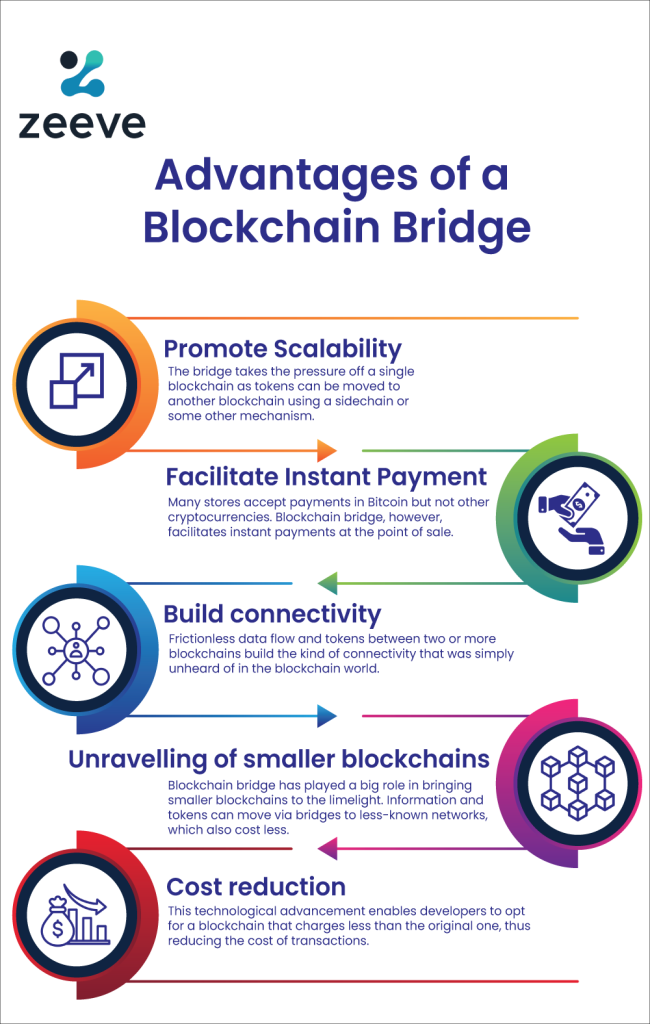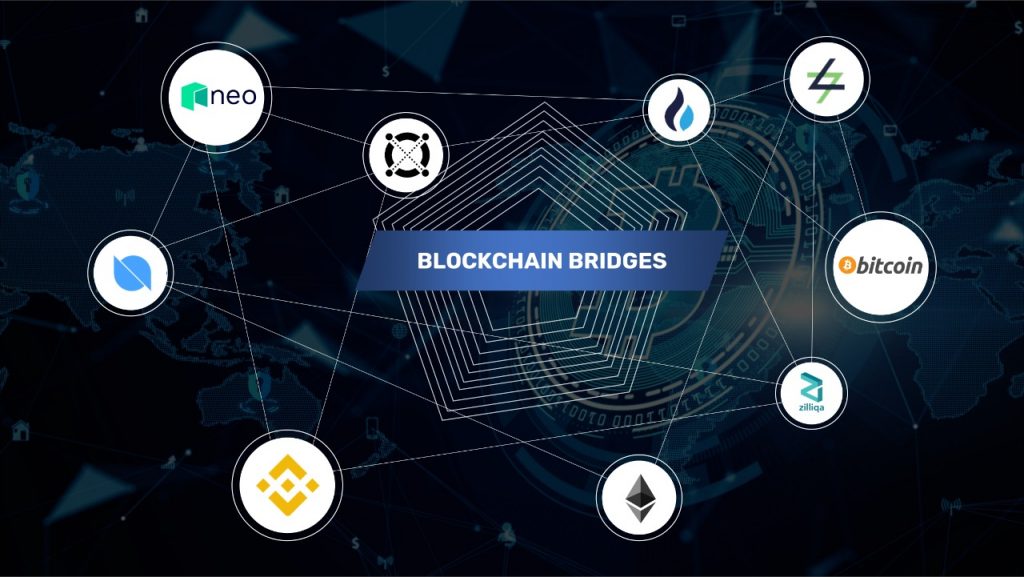Communication is important in every aspect of personal and professional life. Effective communication can foster better trust, strategy, and quality work. Similarly, blockchain networks require great communication between them. Thus the blockchain bridges connecting two blockchain ecosystems act as a communication tool to allow the transactions.
The rise in the adoption of blockchain and Web3 has reached $11.7 billion globally. This has led to the need for interoperability and a secured database.
Blockchains generally resemble islands, content with their own communities and economies, with no mutual exchange of information or value. The tendency of blockchain networks to acquire a siloed nature is against decentralization, the basic principle behind blockchain networks.
Still, we could ignore the formation of blockchain islands had it not cut down innovation and, subsequently economic activities, which are key to the very existence of blockchain platforms and protocols built upon them.
Limitation of Island-like Blockchains
Scalability issues on Ethereum are well-known. Congestion of transactions and exorbitant gas fees has been biting the protocols on the Ethereum blockchain. Yet, finding a faster platform isn’t a practical decision for these protocols as they would end up losing on the benefits that Ethereum brings in, such as a large community, the popularity of a smart contract platform, and a broad-based token standard.
Let us witness another example. Suppose a developer works on an open-source project to get rewarded in a token that has few takers. Value drains out of the bounties if you have no idea how to put these into use.
The solution to Island-like Blockchains: Interoperability
The way out of this problem is to create a bridge among the islands. In the blockchain lingo, it is termed interoperability. The issue gets resolved if a token holder is able to transfer their tokens onto another blockchain. The mechanism unlocks the value tied to tokens on a single blockchain and enables the holder to transfer it to other platforms.
Blockchain bridge – The Technology Behind the Interoperability
A blockchain bridge establishes a connection that facilitates the transfer of tokens or data between two different blockchain platforms, taking advantage of both. A truly interoperable blockchain ecosystem allows tokens, data, and smart contracts to travel between different networks.
Functioning
A bridge operates on some sort of mint-and-burn protocol to keep the flow of tokens constant across the networks. Tokens streaming out of a blockchain are burned or locked with an equivalent number of tokens minted on the next blockchain. When the tokens are transferred back to the original network, the resembling tokens are burned or locked, and the same number of tokens are minted or unlocked in the adjacent blockchain.
Federated and trustless bridges
While the technology broadly operates on these lines, it can be further outlined into two categories –federated and trustless.
The operation of a federated bridge mirrors a private or permissioned blockchain. A protocol has to meet a set of criteria to qualify for a federation that manages bridge transactions. For instance, in a federated setup, some specialized nodes could be locking tokens on Blockchain A using secure multiparty computation.
Tokens with an equivalent value are minted on Blockchain B. When the token holder wants to move their tokens back onto Blockchain A, a threshold of special nodes will need to provide their fragment of the secret key to have the system unlock the tokens.
A trustless bridge, on the other hand, functions via a decentralized network of agents who are incentivized to ensure proper validation of bridge transactions. The mechanism allows anyone to join the network as an agent. For example, a trustless bridge might be using a network of nodes that stake coin XYZ and earn fees from bridge transactions. If any node has doubts over the validity of the transactions approved by any other node, they are free to raise a challenge, which is inquired in line with a pre-determined mechanism.
Types of Blockchain Bridges
Trusted Bridges: These bridges depend on the centralized network; thus the name trusted bridges. A third party operates the bridges, and the bridges require mandatory identification and have a high fee.
Trustless Bridges: The decentralized or trustless bridges are the ones that work by understanding algorithms and working on smart contracts. Here the token price doesn’t change when pegged with an underlying asset.
Use cases of a Blockchain Bridge
A fit-in for a gamut of purposes, blockchain bridges are a big welcome in the blockchain ecosystem. While you may be well aware now of their utility in enabling a token on a network to be used on another, they also serve when exchanging any kind of data, possibly the result of a smart contract call or dissemination of information from oracles. The technology helps an oracle to transfer information such as stock market price feeds or updates of a soccer match from one blockchain to another.
For instance, if an individual might have trusted a company in virtual identity to anchor their verification credentials on Polkadot. Thanks to the bridge, this information could be used for KYC requirements by a stock trading company using Ethereum. The level of decentralization increases with the bridge as the application is not limited by the contours of a single platform.
Bridge – the technology behind a chain of blockchains
Experts now agree that no single blockchain can be omni-efficient. Rather, the practical solution for the use case is to have blockchains specializing in a single functionality and connecting them via a bridge. These blockchains have their own rules, designs, tokens, and use cases, while the bridge(s) provide interoperability between them.
Bridges can be implemented between blockchain networks in several ways. For example, a bridge might serve as a free public utility, while the other might be controlled by a community in return for a profit.
Multiple advantages of a Blockchain Bridge
While interoperability clocks in as a major benefit of the blockchain bridge, there are other benefits as well. Let us take into account the other benefits brought in by a blockchain:
Promote scalability Blockchain networks, especially the larger ones, find it particularly difficult to process a large number of transactions. Millions of transactions happening on many apps are hard to accommodate in the blocks, resulting in delays and hindering operations.
The bridge takes the pressure off a single blockchain as tokens can be moved to another blockchain using a sidechain or some other mechanism. For example, a lot of DeFi apps are now built on Binance Smart Chain (BSC) where even ERC20 tokens from the Ethereum chain can be transacted using the Blockchain Bridge provided by Poly-Network. PolyBridge by Poly-Network supports Bitcoin, Ethereum, Neo, Ontology, Elrond, Zilliqa, Binance Smart Chain, Switcheo, and Huobi ECO Chain.
This is helping the growth of DEXes and other DeFi applications. The growth of DeFi in the last one year has made the need for Blockchain Bridges paramount.
Facilitate instant payment Lack of interoperability resulted in a steep hindrance in the acceptance of crypto as a form of payment. Some stores accept payments in Bitcoin but not other cryptocurrencies. Blockchain bridge, however, facilitates instant payments at the point of sale.
Build connectivity Frictionless flow of data and tokens between two or more blockchains builds the kind of connectivity that was simply unheard of in the blockchain world.
Unravelling of smaller blockchains
Blockchain bridge has played a big role in bringing smaller blockchains to the limelight. Information and tokens can move via bridges to less known networks, which also cost less. This helps in the expansion of the crypto ecosystem.
Cost reduction This technological advancement enables developers to opt for a blockchain that charges less fee than the original one, thus reducing the cost of transactions.

Challenges in implementation
When it comes to integrating a bridge between two networks, there are a few challenges that the companies can reasonably expect to confront. There have been cases when a bridge had to be shut down after launch because bugs in the code were detected. Lack of adequate technical resources becomes another impediment in the course of development.
Wrapping up
When you look at the horizon, the bridge comes across as a technology that can propel the blockchain ecosystem into a new era. At a time when scalability and interoperability have emerged as two major issues negatively impacting blockchains, the bridge has arrived as a dependable solution. As for interoperability, the bridge is by a distance the best solution around. It helps blockchains get over the hindrance of scalability as well, making blockchain-based applications handle the changes regarding the demands of scope.
Connect with Zeeve
Zeeve is the leading Blockchain as a Service platform helping enterprises and Blockchain startups build, deploy and manage reliable decentralized apps and Blockchain networks. Zeeve is a low code automation platform that is cloud agnostic and supports multiple Blockchain protocols with advanced analytics and monitoring of nodes and networks.
Zeeve features a powerful set of APIs to build DApps for a plethora of use cases across industries. Zeeve supports Decentralized Finance (DeFi) space with decentralized storage, trusted nodes and smart contracts. For more details, schedule a free call with our DeFi specialist.






















